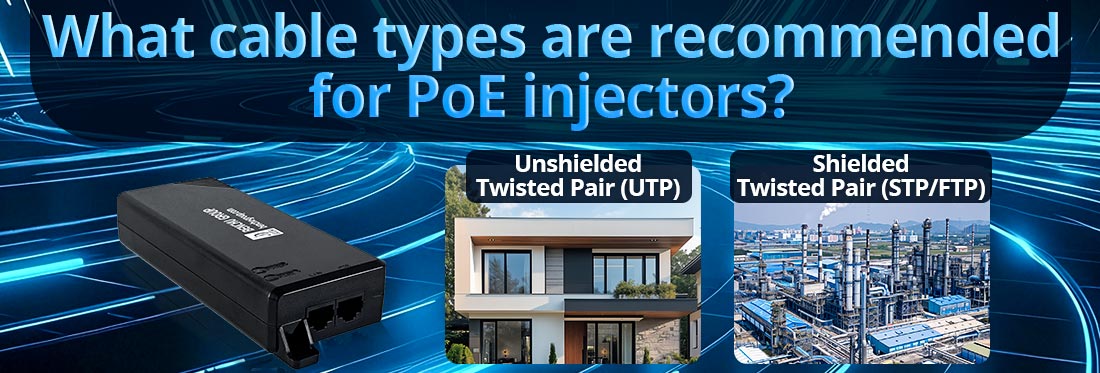
Tipos de cables recomendados para inyectores PoE
Para garantizar un rendimiento confiable y seguridad al utilizar inyectores Power over Ethernet (PoE), es fundamental seleccionar el cable Ethernet adecuado. El cable debe soportar tanto el suministro de energía como la transmisión de datos a largas distancias sin una pérdida significativa de energía o degradación de la señal. Aquí hay una guía detallada sobre los tipos de cables recomendados para inyectores PoE:
1. Consideraciones clave para elegir un cable
Al seleccionar un cable para Inyectores PoE, tenga en cuenta los siguientes factores:
--- Categoría de cable: las categorías más altas (por ejemplo, Cat5e, Cat6) ofrecen un mejor rendimiento y una menor diafonía.
--- Capacidad de suministro de energía: El cable debe manejar la potencia requerida con una pérdida de energía mínima.
--- Longitud: la distancia máxima para Ethernet sobre PoE suele ser de 100 metros (328 pies).
--- Blindaje: Es posible que se necesiten cables blindados en entornos con alta interferencia electromagnética (EMI).
2. Tipos de cables Ethernet recomendados
Categoría 5e (Cat5e)
--- Rendimiento: Admite velocidades de hasta 1 Gbps (Gigabit Ethernet) con un ancho de banda de 100 MHz.
--- Entrega de energía: Adecuado para aplicaciones PoE (IEEE 802.3af) y PoE+ (IEEE 802.3at).
--- Caso de uso: Rentable para la mayoría de los dispositivos PoE estándar, como cámaras IP, teléfonos VoIP y puntos de acceso inalámbrico.
--- Limitaciones: Puede que no sea ideal para aplicaciones PoE++ (IEEE 802.3bt) de alto voltaje o futuras redes de alta velocidad.
Categoría 6 (Cat6)
--- Rendimiento: Soporta velocidades de hasta 10Gbps para distancias de hasta 55 metros con un ancho de banda de 250 MHz.
--- Entrega de energía: Maneja PoE, PoE+ y PoE++ de manera eficiente.
--- Caso de uso: Recomendado para entornos con altas demandas de transmisión de datos o para alimentar dispositivos de rango medio como cámaras PTZ y puntos de acceso de alta potencia.
--- Ventajas: Los conductores de cobre más gruesos reducen la resistencia, minimizando la pérdida de energía y la generación de calor.
Categoría 6a (Cat6a)
--- Rendimiento: Admite Ethernet de 10 Gbps en una distancia completa de 100 metros con un ancho de banda de 500 MHz.
--- Entrega de energía: optimizada para alta potencia PoE++ (IEEE 802.3bt) dispositivos.
--- Caso de uso: Ideal para alimentar dispositivos con altos requisitos de energía, como iluminación inteligente, pantallas digitales y equipos industriales.
--- Ventajas: El blindaje mejorado reduce las interferencias, lo que lo hace adecuado para aplicaciones industriales o de uso intensivo de datos.
Categoría 7 (Cat7)
--- Rendimiento: Admite velocidades de hasta 10 Gbps con un ancho de banda de 600 MHz y proporciona blindaje adicional.
--- Entrega de energía: Totalmente compatible con todos los estándares PoE, incluido PoE++.
--- Caso de uso: Ideal para redes o instalaciones de alta velocidad en entornos propensos a EMI.
--- Ventajas: Ofrece protección y durabilidad superiores para casos de uso exigentes.
Categoría 8 (Cat8)
--- Rendimiento: Diseñado para aplicaciones de centros de datos, admite velocidades de hasta 40 Gbps con un ancho de banda de 2000 MHz.
--- Entrega de energía: excesivo para la mayoría de las aplicaciones PoE, pero capaz de manejar cualquier estándar PoE.
--- Caso de uso: Rara vez se necesita para configuraciones PoE estándar, pero se puede usar en instalaciones de alto rendimiento y nivel empresarial.
3. Tipos de construcción de cables
Par trenzado no blindado (UTP):
--- Más comúnmente utilizado para instalaciones generales.
--- Adecuado para entornos con EMI mínima.
Par trenzado blindado (STP/FTP):
--- Recomendado para entornos con alta EMI, como instalaciones industriales o exteriores.
--- Previene la interferencia de la señal y mejora el rendimiento en condiciones difíciles.
4. Consideraciones adicionales
Calidad del cable
--- Utilice cables con conductores de cobre sólido en lugar de aluminio revestido de cobre (CCA) para una mejor conductividad y durabilidad.
Pleno vs. No Pleno
Cables con clasificación Plenum:
--- Requerido para instalaciones en conductos de aire o espacios plenum donde se aplican normas de seguridad contra incendios.
Cables no plenum:
--- Adecuado para instalaciones estándar donde las preocupaciones por la seguridad contra incendios son mínimas.
Uso en exteriores
--- Para implementaciones en exteriores, utilice cables Ethernet resistentes a la intemperie, resistentes a los rayos UV y al agua.
Pérdida de energía
--- Las categorías más altas y los cables más gruesos reducen la pérdida de energía, lo que garantiza que llegue suficiente energía a los dispositivos de alto voltaje en largas distancias.
Conclusión
Para la mayoría de aplicaciones de inyectores PoE:
--- Los cables Cat5e son suficientes para implementaciones básicas de PoE y PoE+.
--- Se recomiendan cables Cat6 o Cat6a para PoE++ y preparación para el futuro.
--- Utilice cables blindados en entornos con alta EMI o para instalaciones al aire libre.
Al seleccionar el cable adecuado, puede garantizar un suministro de energía confiable, un rendimiento de datos óptimo y una infraestructura de red duradera.